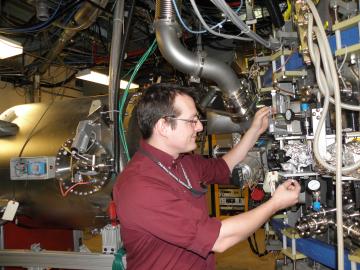
Filter News
Area of Research
- Advanced Manufacturing (2)
- Biology and Environment (11)
- Computer Science (1)
- Energy Science (19)
- Fusion and Fission (4)
- Fusion Energy (3)
- Isotopes (3)
- Materials (6)
- Materials for Computing (2)
- National Security (3)
- Neutron Science (7)
- Nuclear Science and Technology (19)
- Nuclear Systems Modeling, Simulation and Validation (1)
- Supercomputing (13)
News Topics
- (-) Biomedical (22)
- (-) Buildings (1)
- (-) Grid (7)
- (-) Machine Learning (8)
- (-) Nuclear Energy (31)
- (-) Space Exploration (2)
- 3-D Printing/Advanced Manufacturing (28)
- Advanced Reactors (14)
- Artificial Intelligence (8)
- Big Data (11)
- Bioenergy (13)
- Biology (5)
- Biotechnology (2)
- Chemical Sciences (5)
- Clean Water (2)
- Composites (1)
- Computer Science (39)
- Coronavirus (25)
- Critical Materials (2)
- Cybersecurity (4)
- Energy Storage (21)
- Environment (29)
- Exascale Computing (3)
- Frontier (1)
- Fusion (13)
- High-Performance Computing (3)
- Isotopes (8)
- Materials (2)
- Materials Science (37)
- Mathematics (2)
- Mercury (1)
- Microscopy (8)
- Molten Salt (2)
- Nanotechnology (17)
- National Security (2)
- Neutron Science (35)
- Physics (13)
- Polymers (7)
- Quantum Science (14)
- Security (3)
- Summit (17)
- Transportation (15)
Media Contacts

Oak Ridge National Laboratory researchers have developed artificial intelligence software for powder bed 3D printers that assesses the quality of parts in real time, without the need for expensive characterization equipment.

Pick your poison. It can be deadly for good reasons such as protecting crops from harmful insects or fighting parasite infection as medicine — or for evil as a weapon for bioterrorism. Or, in extremely diluted amounts, it can be used to enhance beauty.

Oak Ridge National Laboratory researchers have developed a machine learning model that could help predict the impact pandemics such as COVID-19 have on fuel demand in the United States.

Oak Ridge National Laboratory scientists evaluating northern peatland responses to environmental change recorded extraordinary fine-root growth with increasing temperatures, indicating that this previously hidden belowground mechanism may play an important role in how carbon-rich peatlands respond to warming.

Combining expertise in physics, applied math and computing, Oak Ridge National Laboratory scientists are expanding the possibilities for simulating electromagnetic fields that underpin phenomena in materials design and telecommunications.

After its long journey to Mars beginning this summer, NASA’s Perseverance rover will be powered across the planet’s surface in part by plutonium produced at the Department of Energy’s Oak Ridge National Laboratory.

ORNL researchers have developed an intelligent power electronic inverter platform that can connect locally sited energy resources such as solar panels, energy storage and electric vehicles and smoothly interact with the utility power grid.

Lithium, the silvery metal that powers smart phones and helps treat bipolar disorders, could also play a significant role in the worldwide effort to harvest on Earth the safe, clean and virtually limitless fusion energy that powers the sun and stars.

A team led by Dan Jacobson of Oak Ridge National Laboratory used the Summit supercomputer at ORNL to analyze genes from cells in the lung fluid of nine COVID-19 patients compared with 40 control patients.

From materials science and earth system modeling to quantum information science and cybersecurity, experts in many fields run simulations and conduct experiments to collect the abundance of data necessary for scientific progress.


